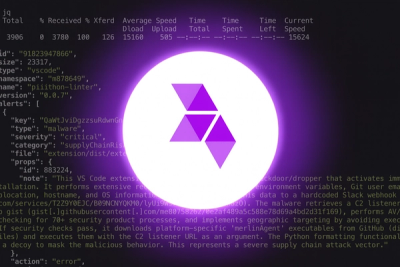
Product
Introducing Webhook Events for Alert Changes
Add real-time Socket webhook events to your workflows to automatically receive software supply chain alert changes in real time.
A wrapper around the native fetch function, returning the response body as a camelCased object

A wrapper around the native fetch function, providing a more convenient way to use it for JSON requests


At its core, Snuffles is just a very slim wrapper around the native fetch function. It allows for setting a base url and default options for your request, provides some wrappers around some of the more frequently used HTTP methods and takes care of all casing. You send camelCased objects in, you get camelCased objects out.
npm install --save snuffles
import Snuffles from 'snuffles'
export default function myApiWrapper() {
const defaultRequestOptions = {
headers: {
'X-AUTH-TOKEN': 'my-secret-token'
}
}
const metaOptions = {
bodyKeyCase: 'CAMEL_CASE'
}
const api = new Snuffles(
'http://base-url.tld',
defaultRequestOptions,
metaOptions
)
const user = api.get('/user')
}
To create a new instance of Snuffles:
const api = new Snuffles(baseUrl[, defaultRequestOptions, metaOptions])
baseUrl: The base url of the API you want to make requests againsdefaultRequestOptions (optional): An Object, containing a set of default options you want to sent in every request, e.g. headers for authenticationmetaOptions (optional): An object containing meta configuration for Snuffles. For possible options, please refer to the list belowSnuffles accepts all options that fetch accepts as its init parameter (docs). In fact, snuffles does not validate the options that are passed at all.
The metaOptions object accepts the following configureations:
bodyKeyCase: A string defining which casing the keys of a request body for outgoing requests should have. Can be either of SNAKE_CASE, CAMEL_CASE or PARAM_CASE.logger: A custom logger function (see Logging section)If no object is passed for metaOptions, the following defaul configuration will be used:
{
bodyKeyCase: 'SNAKE_CASE',
logger: () => {} // no-op logger
}
As of now, Snuffles has wrappers for 5 request methods:
get(path[, options])post(path[, options])put(path[, options])patch(path[, options])delete(path[, options])Where
path: the path you want that specific request to go tooptions (optional): An Object containing a set of options you want to merge with the base options on this specific request. Options passed to the wrapper functions are deep-merged, but will override identical keys.Snuffles does support the setting of querystrings via its options parameter. You can pass in a query object with the desired key-value-pairs.
For example:
const api = new Snuffles('http://base-url.tld')
const options = {
query: {
name: 'sirius',
animal: 'dog'
}
}
const user = api.get('/user', options)
// => fetch('http://base-url.tld/user?name=sirius&animal=dog')
Snuffles will take care of transforming the casing of response and request
bodies, so that you can pass in a camelCased object as a request body (passed
via options.body) and get out the response body as a camelCased object as
well.
Assuming GET https://your-api/users/1 would return a response with a body of
{
"user_name": "John Doe",
"paid_user": false
}
If you make this request with snuffles, it would look like
const api = new Snuffles('https://your-api')
const res = api.get('/users/1')
// res =>
// {
// userName: "John Doe",
// paidUser: false
// }
//
const api = new Snuffles('http://base-url.tld')
const options = {
body: {
userName: 'sirius',
paidUser: true
}
}
api.post('/users', options)
// sends a request to 'http://base-url.tld/users', with the body
// {
// user_name: 'sirius',
// paid_user: true
// }
For normal browser-based development the network tab in your browser's developer tools is probably all you need.
If you should have custom logging requirements (e.g. if you work with React Native, where you cannot use the network tab in the remote React Native Debugger) you can pass in your custom logger function as an option to the 3rd argument of the Snuffles() constructor.
Here is an example using debug as a custom logger:
import createDebug from 'debug'
const debug = createDebug('api')
const apiClient = new Snuffles(
apiUrl,
{ ... }
{ logger: debug }
)
The first argument of each log call is always the type of the log entry (either 'request' or 'response'), so you can take advantage of this to log them differently. E.g. into separate logging namespaces:
{ logger: (type, ...data) => createDebug(`api:${type}`)(...data) }
Beware: if the logs should get persisted/streamed to anywhere, be careful that you could be exposing sensitive information like passwords, API tokens, which are part of the logged HTTP requests.
MIT © railslove
Dog Illustrastion from Pixabay under CC0-License.
Made with 💚 in Cologne
FAQs
A wrapper around the native fetch function, returning the response body as a camelCased object
We found that snuffles demonstrated a not healthy version release cadence and project activity because the last version was released a year ago. It has 3 open source maintainers collaborating on the project.
Did you know?

Socket for GitHub automatically highlights issues in each pull request and monitors the health of all your open source dependencies. Discover the contents of your packages and block harmful activity before you install or update your dependencies.

Product
Add real-time Socket webhook events to your workflows to automatically receive software supply chain alert changes in real time.

Security News
ENISA has become a CVE Program Root, giving the EU a central authority for coordinating vulnerability reporting, disclosure, and cross-border response.

Product
Socket now scans OpenVSX extensions, giving teams early detection of risky behaviors, hidden capabilities, and supply chain threats in developer tools.